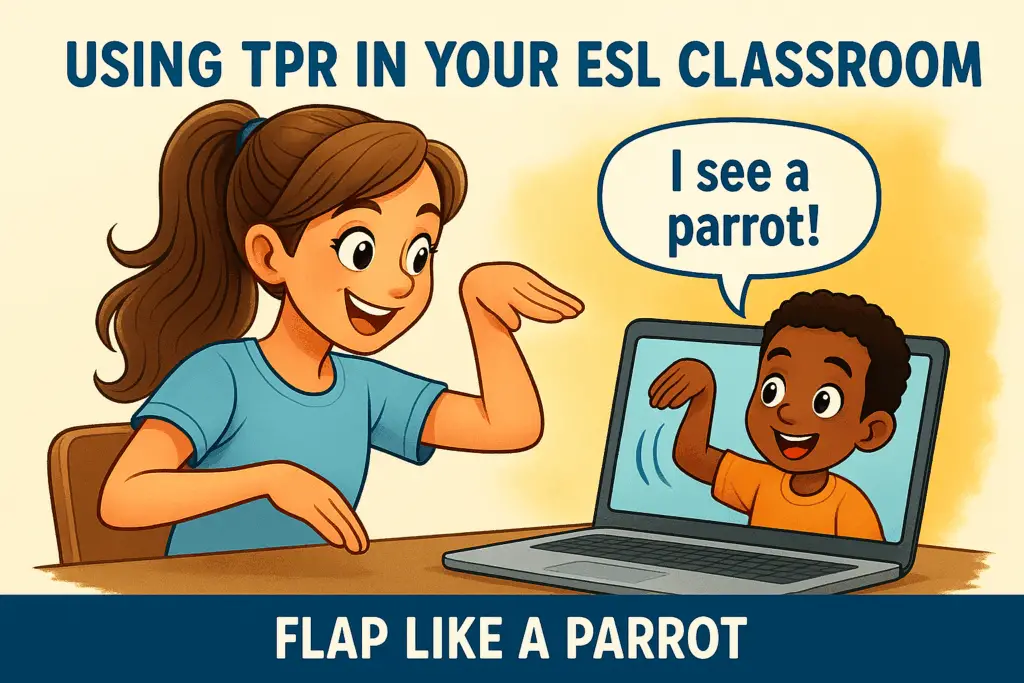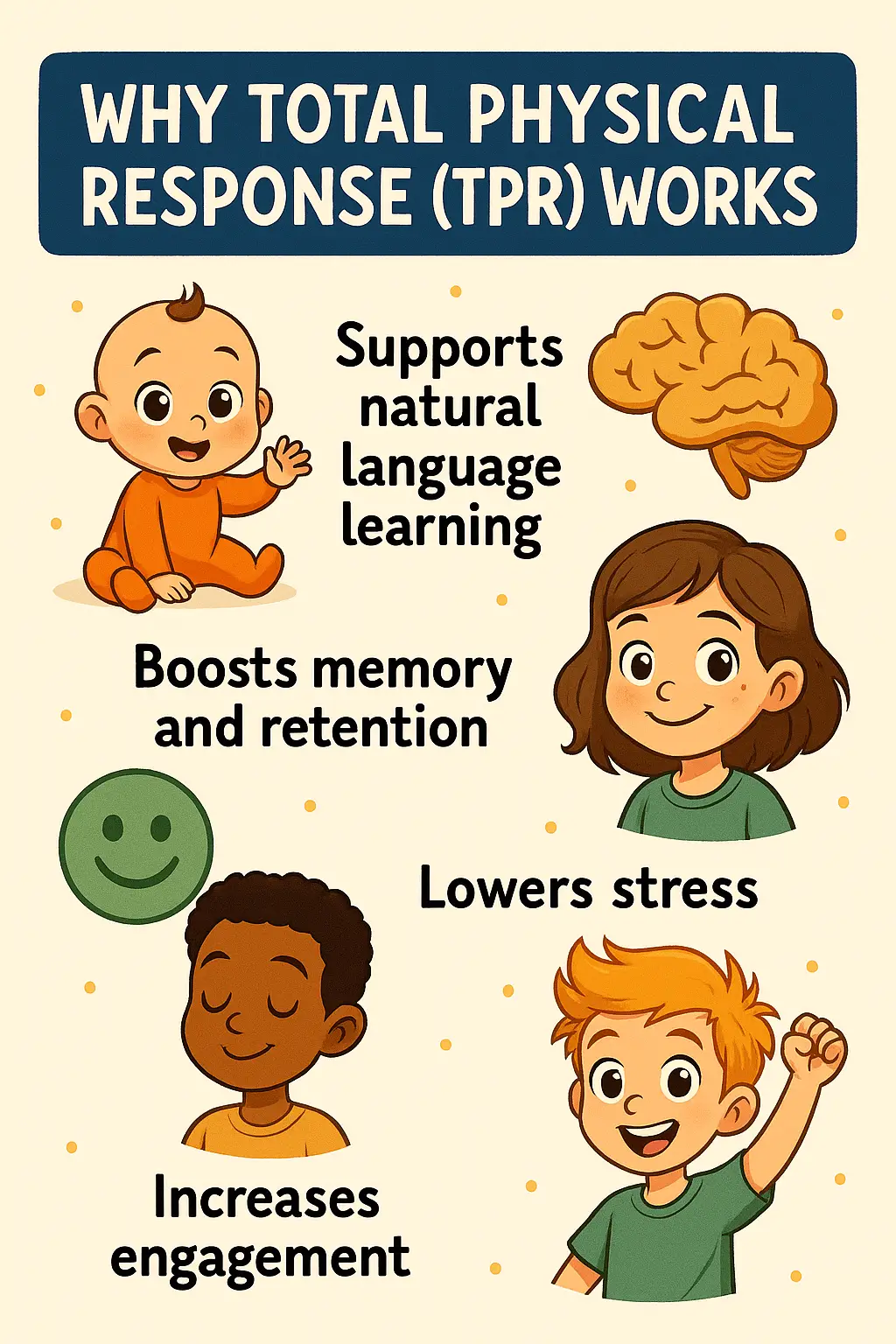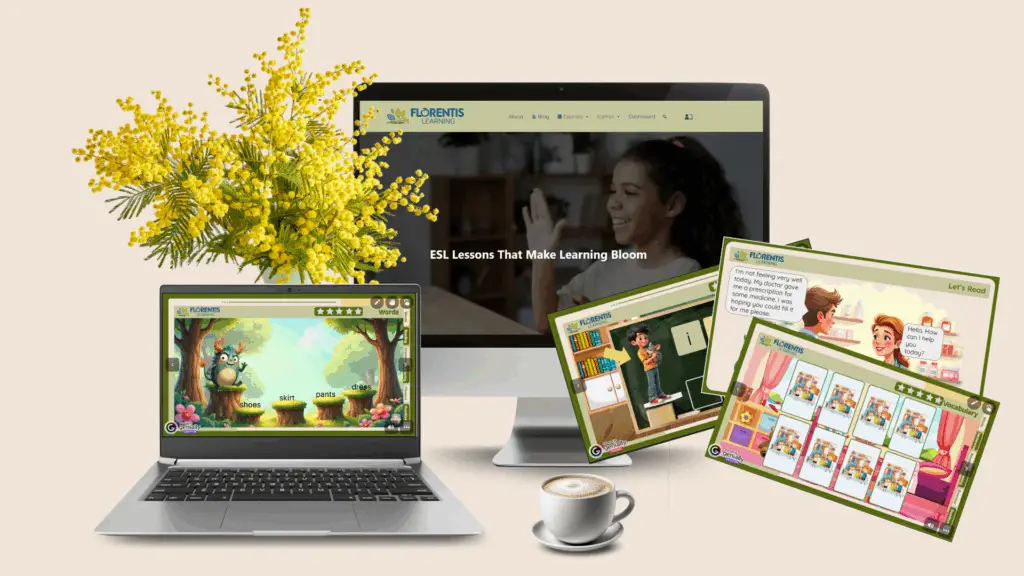
This morning I was teaching a new trial lesson to a 5-year-old student who had limited English. The lesson introduced four jungle animals—monkey, tiger, snake, and parrot. It had a catchy song, followed by letter sound practice, and introduced the sentence frame “I see a ____.” For a student with minimal English, this presented so many opportunities for engaging Total Physical Response (TPR)—like making monkey sounds and scratching our heads, growling like a tiger, slithering like a snake, and flapping like a parrot. Within minutes, my student was smiling, moving, and confidently repeating “I see a tiger!” and “I see a monkey!”
That’s the power of Total Physical Response (TPR). When used well, it transforms language learning from something passive and intimidating into something fun, memorable, and interactive. In this post, we’ll dive into why TPR works and how you can start using it in your ESL classroom—whether you teach online or in person.
What is Total Physical Response (TPR)?
Total Physical Response (TPR) is a teaching method developed by Dr. James Asher, a professor from San Jose State University. It’s based on the idea that because your body is connected to your brain, you can learn better when you use more of your body than just your eyes and ears. We learn languages best when we combine language input with physical movement. Think about how babies learn—they listen, watch, and respond physically before they ever speak.
In an ESL setting, this means students learn by doing. When they hear “stand up,” they stand. When they learn the word “jump,” they jump. The movement reinforces meaning—and makes learning stick.

Why Total Physical Response (TPR) Works for ESL Students
- Supports natural language learning: TPR mirrors how we acquire our first language.
- Boosts memory and retention: Physical movement helps students remember vocabulary and phrases longer.
- Lowers stress: TPR creates a playful, low-pressure environment.
- Increases engagement and encourages participation: Especially with young learners, TPR keeps energy high and attention focused. Even shy students can join in with simple gestures.
How to Use TPR in Your ESL Classroom
Here’s how you can bring TPR into your lessons:
- Start with action verbs – Use common commands like “stand,” “sit,” “jump,” “clap,” or “run.”
- Pair vocabulary with gestures – For example, flap your arms for “bird,” slither your hand for “snake,” or mime brushing teeth for “brush.”
- Use repetition – Do the actions and say the words multiple times in a fun, rhythmic way.
- Model first – Always demonstrate the action and say the word before expecting students to join in.
- Keep it simple – Choose clear, memorable gestures that students can repeat easily.
Tips for Using TPR Online
Absolutely! Here are a few tips for using TPR during virtual lessons:
- Keep your camera at the right angle so students can see your whole upper body.
- Encourage your students to stand up and move—don’t worry if it gets a little silly!
- Spotlight students when they demonstrate a gesture or use a phrase.
- Use digital tools like emojis, reactions, and on-screen visuals to support your TPR cues.
- Play games that require movement (Simon Says, action flashcards, or “Do It If”).
At Florentis Learning, we design our ESL lessons with TPR in mind from the very first unit. Each lesson—whether it’s about jungle animals, food, or weather—includes gestures, songs, and interactive activities that help students connect language to action. When students move, they remember more and gain confidence faster.
Total Physical Response (TPR) in Action: Examples by Age Group
| Age Group | Total Physical Response (TPR) Examples |
|---|---|
| Ages 4–6 | Action songs (e.g. “Head, Shoulders…”), Simon Says, jungle animal actions |
| Ages 7–10 | Act out verbs, TPR storytelling, Total Physical Response Bingo |
| Ages 11–14 | Vocabulary review games, classroom object scavenger hunts, acting out phrases |
| Teens & Adults | Story-building with movement, charades, gestures while repeating phrases |
TPR Best Practices & Mistakes to Avoid
✅ Be consistent—use the same gestures each time you teach a word.
✅ Always model first—don’t just explain the action.
✅ Keep it high-energy—but read the room (or screen).
❌ Don’t overdo it—pick a few key words or phrases per lesson.
❌ Avoid complicated or confusing gestures.
Conclusion
Total Physical Response is more than just waving your arms around—it’s a research-backed, student-approved way to teach language with meaning and movement. Whether you’re helping a preschooler say their first English sentence or supporting older learners through complex topics, TPR brings energy and clarity into every lesson.
🌿 Ready to see it in action?
Try a few of our Florentis Learning lessons—each one includes built-in TPR prompts, songs, and visuals designed to keep students moving, speaking, and smiling.



Leave a Reply